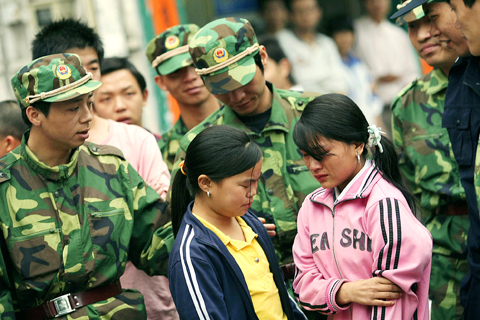China is investigating whether hundreds of children, most aged between nine and 16, were sold to factories in Guangdong Province over the past five years to work as slave laborers, state media said.
Chinese authorities inspected more than 3,600 businesses in Dongguan, the center of the child labor scandal, state press reported yesterday, after children were found working in factories.
The children worked long hours in factories for about US$0.35 an hour, reports said on Wednesday, in echoes of a brick kiln slavery ring that shocked the world last year.

PHOTO: AP
More than 1,000 minors were reportedly found to be working in factories in Dongguan and in nearby Shenzhen and Huizhou, which are also key to Chinese exports.
“In the 3,000-plus factories that we have already inspected, we did not come across a situation of large-scale use of child labor,” Li Xiaomei (李小梅), deputy mayor of Dongguan, told the Southern Metropolis Newspaper.
The probe was launched following the state-run newspaper’s publication on Monday of an investigative report that said the children were “sold like cabbages” by their parents to gangs who then sold them off to employment agencies or directly to factories hundreds of kilometers from their homes.
Most of the children were from Liangshan, a poor farming town in Sichuan Province.
Police have so far rescued 167 children in the city, the Hong Kong-based Wen Wei Po said on Wednesday.
Authorities have set up a task force to rescue other children. So far, 3,629 businesses involving 450,000 employees have been investigated, Li said.
“The government has a very clear cut attitude towards the illegal use of child laborers, and we will resolutely crack down on it. When we find one child laborer, that business will be investigated,’’ Li was quoted as saying yesterday.
The government would also fine the companies as much as 50,000 yuan (US$7,200) if caught, he said.
The initial investigation found that some of the businesses had employed temporary workers from “illegal middle-men,” which could have included child workers, Li told the paper.
He said they had all left the factories before the media reports came out, the Southern Metropolis Newspaper.
The Guangzhou Daily described following police on Tuesday in Dongguan as they questioned young factory workers.
One girl named Luo Siqi from Liangshan said she made 4 yuan per hour, and she initially claimed to have come to Dongguan on her own.
When told by police that the money she thought she was sending home could not have reached her family, she broke down in tears, the paper said.
“My father and mother sold me; I don’t want to go back,” Luo was quoted as saying.

WEAKER ACTIVITY: The sharpest deterioration was seen in the electronics and optical components sector, with the production index falling 13.2 points to 44.5 Taiwan’s manufacturing sector last month contracted for a second consecutive month, with the purchasing managers’ index (PMI) slipping to 48, reflecting ongoing caution over trade uncertainties, the Chung-Hua Institution for Economic Research (CIER, 中華經濟研究院) said yesterday. The decline reflects growing caution among companies amid uncertainty surrounding US tariffs, semiconductor duties and automotive import levies, and it is also likely linked to fading front-loading activity, CIER president Lien Hsien-ming (連賢明) said. “Some clients have started shifting orders to Southeast Asian countries where tariff regimes are already clear,” Lien told a news conference. Firms across the supply chain are also lowering stock levels to mitigate

IN THE AIR: While most companies said they were committed to North American operations, some added that production and costs would depend on the outcome of a US trade probe Leading local contract electronics makers Wistron Corp (緯創), Quanta Computer Inc (廣達), Inventec Corp (英業達) and Compal Electronics Inc (仁寶) are to maintain their North American expansion plans, despite Washington’s 20 percent tariff on Taiwanese goods. Wistron said it has long maintained a presence in the US, while distributing production across Taiwan, North America, Southeast Asia and Europe. The company is in talks with customers to align capacity with their site preferences, a company official told the Taipei Times by telephone on Friday. The company is still in talks with clients over who would bear the tariff costs, with the outcome pending further

Six Taiwanese companies, including contract chipmaker Taiwan Semiconductor Manufacturing Co (TSMC, 台積電), made the 2025 Fortune Global 500 list of the world’s largest firms by revenue. In a report published by New York-based Fortune magazine on Tuesday, Hon Hai Precision Industry Co (鴻海精密), also known as Foxconn Technology Group (富士康科技集團), ranked highest among Taiwanese firms, placing 28th with revenue of US$213.69 billion. Up 60 spots from last year, TSMC rose to No. 126 with US$90.16 billion in revenue, followed by Quanta Computer Inc (廣達) at 348th, Pegatron Corp (和碩) at 461st, CPC Corp, Taiwan (台灣中油) at 494th and Wistron Corp (緯創) at

NEGOTIATIONS: Semiconductors play an outsized role in Taiwan’s industrial and economic development and are a major driver of the Taiwan-US trade imbalance With US President Donald Trump threatening to impose tariffs on semiconductors, Taiwan is expected to face a significant challenge, as information and communications technology (ICT) products account for more than 70 percent of its exports to the US, Chung-Hua Institution for Economic Research (CIER, 中華經濟研究院) president Lien Hsien-ming (連賢明) said on Friday. Compared with other countries, semiconductors play a disproportionately large role in Taiwan’s industrial and economic development, Lien said. As the sixth-largest contributor to the US trade deficit, Taiwan recorded a US$73.9 billion trade surplus with the US last year — up from US$47.8 billion in 2023 — driven by strong